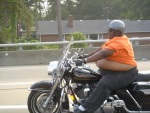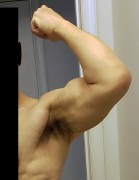|
 Trainers? And I don't think those gloves are done up right, either! Welcome to the all new, improved, and definitely better bike gear thread. Ask questions and give your opinions on anything you can use to protect your tender Goonflesh from the road, plus the two grandís worth of electronics you need to help you get ten minutes down the road to the coffee shop. Iíll try and keep the FAQs and posts up to date and linked here but please PM me if I miss anything. What is this thread for? Discussion of what gear to wear, where to get it from, how to look after it, and all your One Weird Tricks to turn a quarter-hide fashion jacket into a full one-piece race suit. Gear includes all clothing, plus gadgets like helmet cams, headsets etc, as well as luggage and other non-mechanical attachments to your bike. There are dedicated posts explaining what you want to look for in: Helmets Protective clothing Gadgets Luggage These posts will appear as soon as someone writes them - hint, hint. Naturally of course feel free to chip in with your own contributions and corrections. The old bike gear thread - which contains ten years of solid Goon knowledge about the best way of getting sweat out of leather - can be found here. Where can I buy all this stuff? Online retailers: EU: https://www.icasque.com (or change the .com to your local TLD to save the effort of changing pricing) - excellent online retailer for mid-high tier kit, often the cheapest online and a quick google for ďicasque voucherĒ can normally find you a discount. UK: https://www.racevisors.co.uk/ - cheap replacement OE and third-party visors https://www.motohaus.com/ - UK importers of SW Motech luggage, with a good selection of other brands too - excellent customer service. Bricks-and-mortar: UK: Infinity Motorcycles - only decent chain left now that J&S have gone to poo poo. Good selection of kit, friendly staff, and can generally be persuaded to price-match online costs Dainese D-Store - I know Iím outing myself here, but if you want Dainese kit theyíre cheapest and you get proper Premium Brand Treatment. (Please chip in with your recommendations, these are basically just the ones I use) goddamnedtwisto fucked around with this message at 19:09 on Aug 29, 2020 |
|
|
|

|
| # ? Apr 25, 2024 21:28 |
|
Choosing a helmet: Shininess is not the only factor. I'm not going to bother talking about *why* you need a helmet, if you genuinely think you need no head protection on a motorbike you're probably right because you're too loving stupid to live anyway. I *will* try and address the most common bullshit about helmets as it comes up though. Thanks to forums poster Razzled we have a pretty stark demonstration of why you do not gently caress around when it comes to helmets:  Click here for the gory details, but that's a helmet that has literally just saved someone's life. A couple of centimetres of foam is the literal difference between life and death. Buy a good helmet and make sure you take care of it. Construction All crash helmets work on the same basic principle, which is that it isn't speed that kills, it's the sudden stop. The human skull is actually pretty loving robust when dealing with the kind of damage that could be done before some far-ago genius looked at a rock and at the bloke in the cave over who had all the food and invented toxic masculinity. You can take some pretty impressive blows to the skull and get away with nothing more than a cool scar (or in my case, several uncool scars and a big divot I can't really explain). What you *can't* take is sudden, violent changes in direction - that nice hard skull is suddenly a liability when it tries to go into reverse in a hurry and your brain doesn't get the message until it slams into it. What a crash helmet seeks to do is slow the rate at which your head changes direction in an impact. Consider one of the standard BSI certification tests, of dropping a helmet from six feet onto an anvil. If that was your head, it will be trying to decelerate from about 15mph to zero more-or-less instantaneously, surprisingly (but not coincidentally) close to the 100g deceleration that is the area where brain damage becomes likely. If you can instead spread that deceleration over 5/100ths of a second the deceleration is a mere 13g, or about the same as sitting heavily on a chair. The way almost all crash helmets do this is with EPS foam - a high-tech name for what is, essentially, the stuff you get in beanbags and dodgy 70s ceiling tiles. Expanded polystyrene is lightweight, very cheap, easy to form, and crucially is perfectly suited to absorbing and dispersing the huge amounts of energy involved in slowing your great big melon down. It's basically molecular-scale bubble-wrap - billions of little closed cells that pop when it's compressed. Because it takes time for that pressure to build up and the bubble to pop, it tends to gently slow any impact in a way that scales perfectly with increased force, without rebounding (and just causing you the same problem in the opposite direction. Incidentally this is why the received wisdom in some quarters that you can just squash it to shape is dangerous bullshit. Don't do that. It's very, very easy with surprisingly little pressure to compress EPS to the point where any protection it gives is completely gone. Look at that picture of Razzled's helmet again, and wonder if you're willing to cut into that safety margin just to get the wicked cool graphics. More on that in the selection and replacing sections, below. EPS also has a number of drawbacks though. First of all, it's fragile - obviously, because that's how it works, but it's not just fragile in desirable ways. It tears easily (as anyone unpacking an appliance with a cat around can tell you), is very sensitive to solvents (particularly hydrocarbons), is sensitive to both heat and cold, and degrades quickly in UV light. This is solved by having a hard shell surrounding it, normally of some sort of plastic but increasingly nowadays a composite of some kind - more on that in the selection section below. EPS is also an extremely effective thermal insulator, which is not a desirable property of anything touching your skin - a bare foam interior would be intolerably hot in anything above arctic temperatures, which is also a problem because another thing that can dissolve it is sweat, as well as the oils in your skin and hair. It also, as mentioned above, *cannot* be safely compressed to fit, so unless you have it custom-moulded it will not fit snugly enough to stay in place (and because most people's heads are wider at the top than the bottom, it would be impossible to put on without compressing the foam anyway. So helmets will also have an inner liner, normally of some kind of synthetic fabric (some have cotton but that gets really nasty really quickly) with some ordinary open-cell foam rubber in it. This allows the helmet to fit comfortably *and* snugly, and helps keep the helmet in place, as well as protecting your foam. However, there's a limit to how far padding can accommodate the very different shapes of heads people have. Manufacturers will use a form for the interior of the EPS that is something close to average but will vary a bit based on customer feedback. There's old bikers tales about Shoei being shaped like Japanese heads, AGV like Italian ones, etc, but - whatever the brightest minds of the 19th century will tell you - there's not actually an Asiatic skullshape, let alone ridges that denote untrustworthiness. It's literally that there's such a wide variation in head shapes that all manufacturers - even ones like Shark, who change shape with each model - can claim to be working with an "average" shape. (If you're even now flexing your calipers ready to prove that I have the brow of a Welshman, just try on a Shoei and an Arai - both Japanese manufacturers, but they sit at almost exact opposite ends of the range of shapes that helmets come in) Selecting a helmet If at all possible, this is so much easier to do in a shop than online. Nobody really knows what shape their head actually is, and I've never seen two sites (or even two posters) agree on exactly what a "long oval" compared to a "short round" head shape is. There's also a massive range of different options, from cosmetic to functional, which we'll cover first before telling you to completely ignore them. It'll help if you have a rough idea of price and features you're after when you go in, but as with any purchase don't convince yourself you *need* any of them. Let's start with the actual type of helmet first. Broadly there are 3 types of crash helmet: Open face  The original and (not quite) the worst. There is no justification for an open-face helmet - you don't look like Steve McQueen, you look like a muppet. Theoretically provides some protection against head injuries, but...  they fail to protect you in over 30% of crashes where your head touches the ground. In fact the sacrificial structure that saves your brain in those types of crashes is... your face. Even your average goon isn't going to be improved, looks-wise, by using their chin as a crumple zone - get a proper helmet. One thing advocates of open-face helmets will tell you is that they're actually safer, because full-face helmets just snap your neck. As with most bullshit there's the tiniest grain of truth buried in there - the very first full-face lids were just old open-face designs with an added chin-bar, like the OG Bell Star:  While youíre clocking the sealed visor and lack of ventilation - nice and toasty - check the back of it, which extends considerably past the base of the skull. An impact that lifts the head - say going over the handlebars - will bring that lip down onto your spine like a guillotine. This was not a problem with open-face lids with this design because of the whole "face as deformable structure" situation. Modern helmets - even open face - naturally no longer have that design. Also in this category are most MX-style helmets - the chin bar on them is designed to protect your mouth from pebbles and branches while leaving as much space as possible for you to breathe, considering the much harder work of off-road riding. On the road, especially at speed, theyíre going to be hard work, and may even be actively dangerous in a high-speed crash. There are MX-styled full-face and flip helmets if you like the look, but theyíre not really one thing or the other - too heavy and stuffy for serious off-road riding, noisy and draggy at high speeds. If you (think you) have a reason to actually have your face uncovered, consider the next, and newest, entrant onto the scene: Flip-front helmets Also known as "system" helmets (after the BMW System 1 that was the first to properly implement the idea), or "modular" (strictly this is only for helmets where the chinbar is completely removeable). They come in two main flavours - by far the most popular is the Caberg-invented rotational style, where the chinbar and visor rotate up from a position more or less where the visor hinge is on a normal helmet:  (The visor may or may not be flippable independently of the chinbar) There's also the original BMW "Ferry leaving the harbour too quick" style where the entire front of the helmet pivots up from a hinge above the visor, now so rare I can't even find a picture of it - even newer BMW helmets are the rotational style, although considerably chunkier than most. Now it's really important to pay attention to the small print with these kinds of helmets. Some of the cheaper and/or cooler ones aimed at scooter riders are actually legally classified (where the law makes the distinction) as open-face helmets - the chinbar is non-structural and is not likely to offer much protection in a crash. Some are classified as full-face helmets because the chinbar is essential to the structural rigidity of the helmet and they fail crash tests if the chinbar is open, and some (mostly the really expensive, heavy ones) are properly safe in both positions (facial injuries notwithstanding). Personally, I don't see the point if you're not a delivery rider or police and so need lots of face-to-face contact, but I know a lot of people like them. The rules for buying them, apart from the above, are exactly the same as for... Full-face helmets You know what these look like. Generally speaking the safest and most comfortable. Of course there's also an absolute fuckload of... Not actually helmets There's an awful lot of things that people wear on their head that are not helmets. Bandanas to cover up bald spots, anything sold as "DOT APPROVED!!!" (the DOT certification we'll come back to, it's the exclamation marks telling bandana-wearers that this is the bare minimum they need to do to avoid being prosecuted in states that require helmets in the US that we're looking at here. They're basically kiddies riding helmets painted gloss black:  What's great about them is that the fact they have so little foam they're literally pointless in a crash is completely negated by the fact that they'll just fall off in a crash (or after a violent sneeze) anyway. Anyone wearing one of these is a wanker and a coward who's saying "MEEH I'M A SCARY OUTLAW BUT I DON'T WANT THE POLICE TO SHOUT AT ME". Less common nowadays are things that are actually normal helmets but are fatally flawed in some way for bike use. The OG Simpson Bandit, darling of the 90s streetfighter crowd long before The Stig got his supermarket-denim-dad stink on it, is the best example of this:  It's actually designed for open-cockpit car racing and not only lacks enough EPS to pass even the laxer BSI tests for helmets at the time, it also has that spine-guillotine back design (specifically to interact properly with the horse-collar neck protection that some racers wore before the HANS device came along). Simpson do make a compliant helmet now but like I say Top Gear have ruined it. Finally of course we've got those retro helmets like Biltwell and the various other companies churning out Bell knockoffs for the hipster crowd. Anyone wearing one of these is, if anything, even more of a wanker than the armoured yarmulke types - because they're not even street legal, they're just cosplay items. They're for mods who think they're rockers, and frankly anyone in either camp should be getting the flickknives and chains out. Once you know what type you want, you should think about features that you want. Like I say, almost all of these are optional (and you certainly shouldn't pick a helmet that doesn't fit just because it has a particular farkle you have your heart set on). Selecting a helmet - features Shell material and size Shell size is a really useful indicator to look out for - most manufacturers will have less shell sizes than they sell head sizes, meaning if for example you take a Medium helmet you might have a 2XL outer shell with the difference made up with extra EPS. At first this sounds like a good thing, giving you extra protection, but suddenly youíre dealing with a much bulkier and heavier helmet than you need to. Most manufacturers do 2-3 shell sizes, but premium models may have a different shell for each size. Material isnít as important a consideration as it once was. Nowadays itís basically a choice of two - polycarbonate and composite. Polycarbonate is lightweight, cheap and easy to work with. However until recently received wisdom was that it offered less protection than other materials, particularly ABS, because it is much more flexible (ping-pong balls are made of polycarbonate, Lego bricks from ABS, to give you an idea of the difference). The thinking went that in a crash, that tendency to bounce rather than crack would increase the loads on your head and neck, and the flexing of the shell might compromise the EPS before it even had a chance to do its job. As such polycarbonate was banned from most race tracks. However actual testing proved that not to be the case, especially for thicker shells, and in fact that ABS had a tendency to shatter and penetrate the EPS. As such ABS is now basically never used in (road-legal) helmets. Composite materials started turning up in the 70s with glass-reinforced plastic, harder to work with but lighter and stronger than other plastics, and by the 90s various combinations of GRP, carbon fibre, and carbon-kevlar were de rigeur in high-end helmets. Lighter than other plastics and stronger than steel itís still found in race helmets, where the grams shaved are worth the expense, but mostly now not found in any but the most expensive road helmets. Composite lids are still considered safer than other materials, because the shell is also a sacrificial structure - theyíre designed to crack in an impact (technically the epoxy cracks, the substrate retains the integrity of the helmet), meaning that thereís even more impact protection than from the EPS. This however is another advantage of polycarbonate for everyday use - a slight drop of a polycarb lid will have no effect on the crash protection of the helmet, but even a one-foot drop of a composite lid may be enough to start it fracturing internally and compromise the integrity of the shell - see the Replacements section below though. Weight Weight isnít actually as important a factor as you may think. Some say that itís a fatigue thing, but really even the heaviest helmets are absolutely dwarfed by the load put on your neck by just riding at 50mph. Others claim a safety consideration - a very heavy helmet will increase the load on your neck in crashes where you land on your side, risking injury even if the rest of your gear does its job . Since polycarbonate construction became the norm though, most helmets donít vary much in weight any more - normal open-face lids come in between 1200 and 1800gms, with flip-fronts being a few hundred more. ABS lids could weigh over 2 kilos (and the aforementioned BMW System lids even more than that), and there was no particular increase in serious neck injuries among users of those helmets. Toe injuries if you happened to drop one were through the roof, though. Lining Although it may not appear safety-critical, as your ďinterfaceĒ with the helmet, this may be the most important part. It will determine the fit, the comfort and generally your experience, and itís definitely something that helps explain the big price differences between cheap and premium brands. The most basic lining is just some foam rubber with some nylon over it. The padding will be thickest around the cheeks, and this is critical for a good fit (see below), and thinnest around the brow area (which stops the helmet vibrating as much in turbulence). As you go up in price, you start to get some more exotic materials, particularly microfibre to wick away sweat, and/or with antibacterial coatings to keep the smell down. At the top end you start to get interchangeable padding sections to improve the fit, completely-removable liners to allow you to pull the whole lot out and throw it in the washing machine (something that can completely rescue a seemingly terminally-sweaty lid), cutouts for installation of comms systems (see separate post), and even air-bladder systems to get you a perfect custom fit. Visor I didnít put the visor in the construction because construction-wise (and certainly safety-wise) thereís very little to choose between them. However the visor is one of the most important parts of your interaction with the helmet and absolutely should be a major part of your decision. Legally the visor must be clear, although you can buy third-party tinted visors for almost every helmet out there. Tool-free/quick release visor mechanisms are basically universal now even if theyíre all way more fiddly to deal with than they pretend to be, so having a spare visor to swap in when needed in your bag is possible. As well as various degrees of tint, you can usually find various other treatments, either cosmetic (gold/silver/iridium) or functional - yellow tints to reduce glare (old wisdom thatís probably bullshit), polarising filters to reduce dazzle from reflected light (will probably make your LED gauges unusable) and the inexplicably popular photochromatic visor - like Reactions sunglasses, in bright sunlight these visors will slowly darken, then clear as the light goes away. Personally I donít get the point - they take up to 90 seconds to change, so can leave you badly vulnerable for example going through tunnels - but other people absolutely swear by them. Note that many or all of these may be illegal in your particular area. Across most of Europe anything more than a 30% tint (a very light smoke effect thatís basically useless) is illegal, which also includes most of the other types of visors above. Ridiculously you can have sunglasses as dark as you like on underneath though. Some visors are double-glazed to reduce fogging but theyíve almost entirely been replaced by Pinlock. Pinlock is a hydrophilic internal visor insert that - if properly installed - basically eliminates visit fogging. The name comes from the installation method - two small pins glued into holes at the sides of the visor which help keep it pushed tightly in place. Pinlock can be installed on almost any visor but extra points if the pins are already there, and double extra if it comes pre-installed (the inserts arenít cheap). Pinlock also make inserts with most of the treatments mentioned above too, which is usually legal. Some helmets also come with a second, internal tinted visor that can be flicked up and down separately which is a really useful thing if you do a lot of urban riding, coming in and out of shadow a lot, or live somewhere where youíve literally no idea whether or not the sun will be out. Arai and a few other manufacturers do the same trick but with an external visor that covers a small portion of the main one (a high-tech and expensive version of the old racer trick of just putting tape across the top of the visor to use like a sunshade in a car). One feature some riders appreciate is a way of locking the visor a little bit open - sometimes this is on the ratchet of the mechanism itself, sometimes itís a little wedge on the mechanism or the chin bar that stops the visor closing all the way. Pinlock and improved vents make this pretty much redundant (and noisy!) but itís a nice-to-have feature if youíre going to be in particularly hot or cold weather. Strap closure Most helmets come with the standard D-ring closure on the strap - itís easy to use, very reliable, and very secure, but some people really struggle with them especially with cold hands, or might want to take the helmet off without taking their gloves off, or just fancy something different. Some helmets come with a quick-release - basically like a car seat-belt release - which is a bit bulky and requires readjustment if you want to wear a scarf or something, but is without a doubt the easiest one to use. The other common method is the ratchet - basically something like a very sturdy ziptie with a release, which is almost as quick to use but retains the flexibility of the D-ring. However, note that both of those systems *may* fail unsafe, unlike the D-ring, and as such are banned at many tracks if you are thinking about going racing. Vents and aero features Almost all helmets will have some sort of ventilation built in (beyond having an opening visor). Vent design, along with the rest of the aerodynamics, is one of the features that really differentiates the cheap from the expensive, but itís not as simple as more vents = better than. Vents - being holes through the shell and EPS and having a moving part on the outer shell - need careful design to avoid weakening the helmet, and badly-designed ones will introduce a load of noise into the helmet at speed. Broadly you want at least two - one at the front and one at the back - to allow hot air to be drawn out (although some designs use wizardry to eliminate the exhaust vent). A well-designed lid will also have some sort of aerodynamic features. Those old ping-pong-ball helmets were almost the worst possible design - at speed they generate a huge amount of drag and lift that put a huge amount of strain on your neck. Newer helmets have shapes that are designed to eliminate that as much as possible, but again on cheap helmets they can produce odd effects like vortex shedding (which feels like someone pulling the helmet side-to-side) and turbulence throwing you in every direction. This is something you canít really assess in the shop and youíll have to read reviews about, but like I say this is definitely something that more expensive helmets do better than cheap ones. Chin curtains, neck rolls, and other ancillaries Some helmets - particularly ones designed for touring and long-distance riding - will come with a detachable chin curtain, a little strip of cloth that covers the gap between your chin and the chin bar. This can considerably improve the noise insulation of the helmet, at the expense of reducing the amount of ventilation (which might be a good thing in colder climates). Similarly some will have a detachable neck roll, a thicker bit of cloth that covers most of the bottom of the helmet - this can improve fit and comfort, although theyíre mostly out of fashion now, with the neck roll integrated into the lining or absent altogether. Other useful little things to have are nose guards - a little bit of plastic you can attach to the chin bar to bridge the gap between your nose and the chin bar, to deflect your breath down and away from the visor to reduce fogging. Certifications Thereís a fairly baffling array of different certifications for crash helmets - Iíll cover the main ones here. Suffice it to say if the one youíre looking at doesnít have at least one of them, forget it. ECE 22.05 This is a worldwide standard that guarantees a minimum baseline of protection (based on the old green-label British Standard BS 6658:1985.1, fact fans). Any ECE-certified helmet should be road-legal in just about every country on Earth apart from the US (of course). DOT (FMVSS 218) A US standard required for a helmet to be legal on the road in the US. The standard is slightly more generous than ECE (allegedly because ECE was converted to metric and rounded up from the old BSI standard which, as the first legal standard in the world, was copied by everyone else) but crucially unlike all of the other certifications here is it *self certified* - that is the manufacturer can just slap a DOT sticker on anything they want and sell it as DOT-approved. In theory the DOT are supposed to test random samples and fine the manufacturer for any non-compliance. Guess how well thatís going? If you see a helmet with *only* a DOT certification, just walk away. ACU The Auto Cycle Union, the governing body for UK motorcycle racing, certifies helmets at two standards - the ACU Silver Star (very rarely seen) is for open-face helmets, and the Gold Star for full-face. The FIM, the international body, has adopted the ACU standards so youíll see the gold stars on helmets all over the world (although theyíre not an absolute requirement outside of the UK). Youíll need a Gold Star (or international equivalent) helmet to compete in almost any kind of motorsport, and itís also a handy ďThis helmet is better than the bare legal minimumĒ standard). Snell The Snell Memorial Foundation in the US run an independent testing programme that is considered about the highest standard for helmets in the world. Itís entirely voluntary, but if youíre buying a US-model helmet and itís *not* Snell-certified thatís probably not a great sign. Thereís some people who claim - like with SHARP and ACU - that the racetrack-focused standard is actually too high, and somehow makes helmets less safe in lower-energy impacts. This opinion is very popular among makers of helmets that pass ECE or DOT but fail Snell - but it is, of course, complete bollocks. Notably none of these complaints are ever able to point at a helmet that passes Snell but fails other standards. SHARP Not technically a certification, the Safety Helmet Assessment and Rating Programme is a UK government initiative seeking to close the gap left by the deprecation of the old BSI standards when the UK adopted the ECE standard. The BSI offered three levels of certification (known as white, green and blue by the colours of the labels applied to helmets that passed the tests). Similar to the Snell standard, SHARP uses a much higher-energy impact, as well as multiple impacts on multiple points. Unlike Snell, it also publishes the full results and offers a score out of 5 rather than a simple pass/fail. A 1-star SHARP rating is equivalent to an ECE certification (technically itís actually slightly below the ECE standard but itís not a distinction worth bothering with). 3 stars is roughly equivalent to both Snell and ACU Gold (although SHARP allows open-face helmets unlike those), and a 5-star is informally ďAny crash that beats this rating is going to kill you half a dozen other ways firstĒ. The SHARP website is searchable and also includes info on other features like closure type, shell sizes, and other information handy for selecting a helmet. As with Snell, manufacturers who regularly score low on the SHARP ratings claim that itís too harsh and actually leads to a less safe helmet, and just like Snell itís a completely ridiculous insinuation that theyíre never able to prove without the sort of tortured logic you hear from ďActually helmets kill more people than they saveĒ types The only real drawback with SHARP is it only tests helmets sold in the UK - as some manufacturers donít (officially) export to the UK theyíre missing from the list, and other manufacturers have different helmets for different markets. If you canít find the one youíre interested in on SHARP but it is at least Snell or ACU-rated itíll probably be fine. . Fitting a helmet This is absolutely the most important part. A £50 helmet that fits will give you much better protection than a £500 one that doesnít. If at all possible, do this in a shop rather than online, especially if youíre not sure what size and shape your head is. I personally have a prejudice against online shopping for helmets *anyway*, but this isnít the time and place. Once youíve found one thatís the right combination of cool graphics and amazing features, grab something thatís close to your size - manufacturers publish sizing guides but as they never seem to measure from exactly the same spot itís still pretty hit and miss. Pop it on (resist the temptation to force it on - if itís too small youíll know, go up a size). It should feel very slightly too small around your entire head (think of a baseball cap done up a bit too tight). Donít worry if it feels really tight around your cheeks, thatís normal for a new helmet. Do the strap up and try to rotate the helmet on your head in all directions (moving the chinbar left and right and up and down, then trying to twist it), and try to pull the helmet off from the back.. If it moves any further than a cm or so (basically the slack in your skin) itís too big, go down a size. Sometimes you get lucky with your head size and shape and find one that doesnít feel tight but which still wonít move, which is why itís important to do the tests with trying to move it rather than just going on feel. If it *doesnít* feel equally tight around your head it probably isnít the right shape for you. A little gap above the ears is fine (particularly if youíre going to wear glasses under it), and a gap at the very top of the head is okay too. Try a helmet from a different manufacturer (this is where a decent shop is invaluable, because they should be able to advise you what to try based on where it feels tight. Once youíve found one that doesnít move and feels okay, leave it on for a good ten or fifteen minutes (this is a good time to try out the vents, and also confirm how cool you look in it). If you notice any hot-spots - areas that get more painful as you leave it on - then again it isnít the right shape for you. Some people will tell you that you can compress the foam in those areas to rectify this but thatís a really, really bad idea. Compressing the foam in one spot can fatally weaken it, and while itís extremely unlikely, that sort of compromise could be the difference between having a cool story for the pub and having your loved ones at the side of your bed saying ďHeís in there, I know he isĒ, which really isnít a price worth paying for the Monster Energy Limited Edition lid youíve got your eyes on. If after ten minutes the helmet still feels good, youíre good to go. Donít be afraid to keep trying different ones on until you find a perfect one. Itís also a good idea to bring any glasses/sunglasses youíre going to want to wear with the helmet to make sure you can get them on and off with ease - most helmet liners are designed with this in mind but some arenít, or some combination of the liner, your particular head shape, and the design of your glasses might make it impossible to get them on or wear them comfortably. Once youíve settled on one, make sure you get a fresh, boxed one. Donít accept the display model - youíve absolutely no idea how itís been treated. Ever noticed just how flimsy the boxes helmets come in are? Thereís a reason for that - itís a great telltale for how the helmet has been shipped or stored. If itís damaged, ask for another. When they bring it out, it goes without saying that you should check it actually fits (again, youíve no idea how old the one on the shelf is and how many giant melons have been thrust into it). Congratulations, youíve got a new helmet. Now letís talk about getting another new one! Replacing a helmet Probably nothing causes more spirited debate among bikers than when itís time to replace a helmet. Of course many will do it every year when the new colours come out, but for the rest of us, thereís a few clear end-of-life indicators. Crash damage If youíve had a crash at any speed and the helmet hit the ground, itís replacement time. EPS is a one-time thing, and even the most measly walking-speed crash, if the helmet touches down, is enough to weaken it considerably. If this seems harsh and expensive, try crashing less. Wear and tear This is going to vary hugely depending on the helmet and your use of it, but the reliable indicators are that the helmet starts to feel looser than before, any kind of fraying on the straps, notable cracking or discoloration of the EPS (move the liner around to be sure), any noticeable discoloration of the outer shell, and any scratches or dings that go through the paint to the shell underneath. More subjectively, stuff like visor ratchets getting too loose, fraying or tearing of the liner, scratches that donít go through the paint, and just general shabbiness are an indicator that you should at least be considering a new lid. Non-crash damage On top of general wear and tear, you should consider replacing the helmet if it sustains any kind of damage likely to compromise its safety. As mentioned with composite helmets, this could be as small as a drop from a couple of feet, or from 4 or 5 feet for polycarbonate lids (the mechanism is different - a polycarb shell will easily survive a fall from far greater heights, but by deforming and springing back. As the EPS is much less flexible than the shell, this could lead to it cracking or otherwise deforming in a way that fatally compromises it. In both cases, major manufacturers may offer an inspection service for this kind of damage - 99 times out of a hundred theyíll tell you to replace it for liability reasons, but again weíre talking about your head here so itís not something you want to take a chance on. Age Almost all manufacturers specify a lifespan for their helmets - normally 5-7 years - but this is a shelf life, not a service life. The date of manufacture will be clearly marked on the box and should be on a label somewhere in the helmet (check inside the liners and under the straps). Once you reach that lifespan, no matter what state the helmetís in, you should seriously consider replacing it. EPS degrades over time, as do most shell materials. Because of the massive difference in uses, itís impossible to say what the actual service life of a helmet should be. Personally Iíve found 3-4 years is generally the point where I want to think about replacing it, but thatís going to be a personal thing. Other helmet FAQs Can I repaint a helmet? What about stickers? Short answer Yes if, long answer no but. Repainting a helmet is certainly possible but you have to *really* know what youíre doing, and itís definitely best left to the pros. Painting over an existing design just wonít work, you need to take it all the way back to the shell, and a bit of over-enthusiastic sanding could be enough to fatally weaken it. Normal paper stickers are fine (but they *will* look like poo poo in very short order). Plastic stickers are also fine - but you have to be incredibly careful about how you take them off (see the removal section in the helmet cam thread). Vinyl stickers should only be used if the adhesive is clearly marked as being paint-safe - some (probably most) have solvents in the adhesive that will weaken and damage the lacquer. Nobody needs to know to keep honking while you reload enough to risk that. Should I buy a helmet second-hand? Absolutely not. You know that time you bought a really clean-looking bike off a guy who gave you all the receipts for every service, but then you found out heíd used superglue as gasket material and there was a fingernail in the fork oil? Now imagine giving that guy the power to decide whether you live or die. All POs are idiots, never forget that. Your question here Iíll try and keep this updated with any more questions that come up regularly, but if you think of one that gets asked a lot let me know. Also let me know the answer, Iím not getting paid for this. goddamnedtwisto fucked around with this message at 20:19 on Mar 17, 2021 |
|
|
|
Placeholder for clothing post - buy Forma Adventure Lows.
|
|
|
|
Communication - thanks Horse Clocks Want to listen to music, take calls, chat to other riders in your group, listen to GPS instructions? You probably want a Bluetooth intercom. They range from what is effectively a Bluetooth headset for your helmet, to high-end multi-channel Bluetooth + Mesh systems. The two big players are Sena and Cardo, there are hundreds of other brands but nearly all of them just sell basic units from China. Low-End, Simple Units If you're a solo rider, use your phone and only your phone for music, navigation, calls then you only really need a simple system. Generally they have one or two Bluetooth channels for connecting to your phone or another intercom. Products in this category are: Sena 5/10 Series, Cardo Freecom 1/2, Nearly everything from every other manufacturer. Prices range from $20 for garbage, to $150 for the Freecom 2. Mid-Range, Multi-Channel intercoms If you ride with a pillion, ride in small groups, or have separate phone & GPS, you might want to consider a mid-range system. With more Bluetooth channels, they're capable of small group chats of up to 8 people (via one central rider), can connect to multiple devices at one time (e.g. phone, gps and intercom) and mix the audio appropriately. Products in this category are: Sena 20 Series, Cardo Freecom 4, Prices range from $300 for the 20S/Freecom, to $500 for the Sena 10C Evo (Which doubles as a 4k helmet camera). High-End - Mesh Intercoms If you ride with a large group, or just have a friend who has a mesh unit too, this is what you want to buy. Sporting all the features as their mid-range cousins, they also support mesh networking capable of up to 15 riders in one group chat. The mesh protocols work over longer range (Don't buy into the '2 mile range' bullshit, that's only the case if you have 15 riders evenly spread out over that distance), and have better resilience to obstructions to line of sight. Unfortunately, the mesh protocols used by these systems aren't standard so a Cardo mesh can't talk to a Sena mesh and you'll have to fall back to standard Bluetooth intercom. Some units support 'patching in' Bluetooth (or phone) to a mesh chat allowing non-mesh riders to be involved. If you have a low/mid-range unit, Sena also make a Bluetooth->Mesh adapter that sits on your handlebars and can 'upgrade' your unit. Products in this category are: Sena 30/50 Series, Cardo Packtalk Series. Prices sit around from $300-$350 for this category. How well do they work? Honestly, Bluetooth intercoms in my experience are garbage. They all boast "universal connectivity" but even then getting two units to connect can be a frustrating experience. Once they are connected they'll disconnect if they think you're going to go out of line of sight, and then you're back again trying to get them to connect. It's honestly easier to just use your phones and call each other. Mesh intercoms on the other hand, I haven't had a bad experience with. Sena's 30K units seem to handle distance, non-line-of-sight, and connection is as easy as flipping up the antenna. What should I buy? If anybody you know has a Cardo or Sena mesh unit, buy one to match. If you ever go riding with them, you'll be thankful for it. If you can convince your riding buddies to buy the same, go Mesh. I don't think there's much difference between Sena and Cardo, except mabye Cardo ships with JBL speakers. Otherwise, I'd buy either a mid-range Cardo or Sena. The multi-device capability is nice, and if you ever ride with a buddy you might be lucky and manage to keep a bluetooth intercom open for your ride. I certainly wouldn't waste my time or money on low-end units. If you really want range, buy a PMR radio, or get an amateur radio license and use DMR. Anything else to consider? Some units (e.g. Sena 30K) allow you to plug in headphones, if you value your ears using foam in-ear headphones plugged into your intercom is a great way to filter out wind noise, and not need the volume cranked up to 11 to hear anything. Not all helmets will work with all intercoms. Some use a clamp system which needs to get between the neckroll and shell of the helmet to work, some have a boom mic that seriously restricts placement of the main unit. Some intercoms are made specifically for individual helmets (e.g. Sena SRL2 for the Neotec II helmet). If you can, buy at a decent brick and mortar store, they will help you with fit and compatibility. ed note: I've always preferred Cardo as they have genuinely great customer service, sending me out a replacement clamp, securing bolts, and a couple of mic muffs for free after I just dropped them an email asking if the bolts were sold separately after losing one moving the unit from one helmet to another - alas none of their current systems comfortably fits a Shoei GT Air. I'm currently using a Sena SMH10R because I have no friends so don't care about the intercom, and the modular design means you can mount it anywhere, and the quality is fine but finding somewhere for all the extra slack wire is a nightmare - goddamnedtwisto goddamnedtwisto fucked around with this message at 19:07 on Aug 29, 2020 |
|
|
|
Placeholder for luggage post - if you can't do it with bungees and plastic bags, are you really a biker?
|
|
|
|
|
|
|
|
Add a tl;dr buy a RF-1200 to the helmet post. but thanks for getting this started!
|
|
|
|
MomJeans420 posted:Add a tl;dr buy a RF-1200 to the helmet post. Weirdly, despite the rest of their range fitting me perfectly, the RF/Neotec/NXR don't even come close to fitting - they feel much more like an Arai but with an even bigger crown.
|
|
|
|
dats a whole lot of words about helmets when you can just say "buy a shoei" 
|
|
|
|
goddamnedtwisto posted:Placeholder for luggage post - if you can't do it with bungees and plastic bags, are you really a biker? The waterproofing 'covers' that came with my soft luggage tore themselves to pieces after an hour at 80, the trashbags tightly tied over my soft luggage lasted 13 hours of thunderstorms. Always pack trashbags.
|
|
|
|
goddamnedtwisto posted:Placeholder for gadget post - seriously, why do you need your phone on your handlebars? This is the best motorcycle cover
|
|
|
|
I'll recommend https://www.quadlockcase.eu/ At first I didn't want to get it, as the price is very steep, but so are all the alternatives. This one looks the best when left on the bike without any device. They sell a stick-on mount that you can stick to any cheap phone case and that creates a perfectly fine phone adapter for any smartphone you could own. You can also stick that thing to anything else you might want to temporarily mount to your motorcycle. The action is very well engineered, can be done flawlessly with one hand and gloves don't change a thing. You can also mount in both panoramic and vertical mode, however depending on how you fixed the mounting plate, getting it off will be harder in one of the two positions. The reason I looked at this was that my bike as a 12(?)mm accessory bar and most options for that are either expensive as gently caress or intended ONLY for mirror stems. Don't get me wrong, apparently theirs is too, but it works amazingly with my accessory bar. I usually ride without anything mounted on there and it really is the best solution to just leave on your bike and never notice. A RAM mount would look terrible left on the bike, so would any other "grippy" type. Also there's induction charging apparently. (No wires, no mess for all you people that have that) My only regret is buying other phone cases to try and forgetting to send them back to amazon in time.
|
|
|
|
I'll also vouch for quadlock setup. It's really unobtrusive and I don't need to worry about my phone slipping a rubber X-mount so don't need to lash it down with rubber straps. Looks very sleek. I almost bought their Qi charger mount but it doesn't seem to be compatible with a RAM fork stem adapter which I've had to .. mechanically fix in place due to how my Ninja 650's fork stem nut works -- long story -- so I can't really swap it out with their own mount now. If they ever release a Qi charger with a RAM ball adapter I'll be on it so fast. e: I can't even find their bike-specific Qi adapter on the site anymore -- I swear they had one since I ordered it and cancelled the order so maybe it's discontinued? On actual wear-gear topic, I'm going to go check out a bunch of mesh jackets and pants this weekend. My only textile jacket was the one I lowsided in and the seams on the arm are finally giving out enough that it's less "it looks ratty but would probably still be ok in a slow slide" to "umm I'm not sure the textile will be there if I slide" so it's time to replace. I still like the Dainese superspeed tex jacket I had so I'm open to buying another but I'm going to check out some RevIt and Icon alternatives to see if I can get the same without the big D price tag. some kinda jackal fucked around with this message at 13:46 on Aug 28, 2020 |
|
|
|
Thirding the Quadlock. Your phone will stay connected even if your bike hits a guardrail at 55mph and goes spinning 100yds down the highway. And somehow the case will prevent your phone from shattering. The only drawback is the powered connectors that do Qi charging will gently caress with your GPS, but that's more a drawback to Qi charging than the case/mount.
|
|
|
|
I have the RAM quick grip holder, which is beefy as hell from a durability standpoint and bafflingly cheap for a RAM product provided you have the mounts to mount it to https://www.rammount.com/part/RAM-HOL-PD3U Plus itís super quick to get your phone in and out, no lever pulling or rubber strap fuckery
|
|
|
|
I'm never going to rely on anything that requires adhesion, special phone case, or magnets. The ball mounts are universal, and are available to mount on anything including handlebar itself, handlebar mounting hardware, lever screws, mirror mounts, etc. There are not unique to RAM brand. They have been the most reliable so far, according to off-road folks. In fact, you can build yourself a new folding mirror mount https://www.doubletakemirror.com/ https://youtu.be/9OdChYlKTWQ In the land of on-road riding, The only phone holder failures I've seen, all were at the detachment point. Make sure whatever you buy has a fail safety mechanism. The rubber band backup may spoil the pristine look of your handlebar landscape, but it will keep that $900 phone attached. And those asking why you even need a phone on the handlebars? For real?
|
|
|
|
Nitrox posted:I'm never going to rely on anything that requires adhesion, special phone case, or magnets. The ball mounts are universal, and are available to mount on anything including handlebar itself, handlebar mounting hardware, lever screws, mirror mounts, etc. There are not unique to RAM brand. They have been the most reliable so far, according to off-road folks. In fact, you can build yourself a new folding mirror mount https://www.doubletakemirror.com/ yea fr, if you can't think of a reason to have your phone on your bars you need to move beyond practicing figure 8s in the cul de sac
|
|
|
|
Nitrox posted:I'm never going to rely on anything that requires adhesion, special phone case, or magnets. The ball mounts are universal, and are available to mount on anything including handlebar itself, handlebar mounting hardware, lever screws, mirror mounts, etc. There are not unique to RAM brand. They have been the most reliable so far, according to off-road folks. In fact, you can build yourself a new folding mirror mount https://www.doubletakemirror.com/ Yeah, for real - every thing I need my phone to do while I'm on the bike (play audio, call out turns, make and answer calls) I can do without the phone never having to leave my pocket - anything more involved you should be pulling over for anyway. It's slightly less convenient I'll admit but for me at least the additional security (including the likelihood of the phone surviving a crash) and massive battery life savings of having it safely tucked inside a nice waterproof leather/kevlar cell is well worth it. (FWIW I also do the exact same thing when driving a car, although then it's more about the sheer amount of times I've just left my phone in the holder)
|
|
|
|
Razzled posted:yea fr, if you can't think of a reason to have your phone on your bars you need to move beyond practicing figure 8s in the cul de sac Yeah, I'm not taking lectures on being a Grizzled Veteran Biker from someone who was target-fixating into street furniture when I was into my third decade of riding, thanks.
|
|
|
|
goddamnedtwisto posted:Yeah, I'm not taking lectures on being a Grizzled Veteran Biker from someone who was target-fixating into street furniture when I was into my third decade of riding, thanks. boohoo, GPS and being able to see who's calling without answering are good enough reasons to mount your phone. maybe not if you have the multi-tasking ability of a two year old though i guess
|
|
|
|
Razzled posted:boohoo, GPS and being able to see who's calling without answering are good enough reasons to mount your phone. maybe not if you have the multi-tasking ability of a two year old though i guess My phone calls out the turns and also tells me who's calling, maybe if you weren't staring at your phone trying to work out where the turn was there'd be a few more intact mailboxes around your way.
|
|
|
|
goddamnedtwisto posted:My phone calls out the turns and also tells me who's calling, maybe if you weren't staring at your phone trying to work out where the turn was there'd be a few more intact mailboxes around your way. i love that you're so butthurt over something that happened once to *me* 6 years ago, nevermind that i've not been down in the street again since
|
|
|
|
E:nm
|
|
|
|
I think people who want their phones on their handlebars should put them there, and people who want their phones in their pockets should put them there. Hope this helps. Personally I donít want to talk on the phone while riding, or driving, or really ever at all.
|
|
|
|
I've been following a new amateur racer on Youtube. In a recent race, he had a highside wihch illustrates pretty well the importance of having good boots. He breaks his ankle on the highside even with excellent race boots and you can see his ankle fold under him as he tries to stand after his crash. He also broke a vertebrae, https://www.youtube.com/watch?v=OGRnC1Cr8HI&t=524s
|
|
|
|
Razzled posted:i love that you're so butthurt over something that happened once to *me* 6 years ago, nevermind that i've not been down in the street again since I love that within six months of that you were Kramering into threads to sonny-jim people with all your experience and no actual substance or discussion, just a flat declaration that the way you do things is the only correct way, and that the only possible reason that someone may not do things that way is that they are an INFERIOR BIKER - and this is a pattern you have every single time I see you post in this forum. I mean if we're going to whip 'em out, I was using a mounted Tomtom for navigation and call display in 2005 (because none of the major phone manufaturers had navigation for poo poo until like 2009-ish), have at various times used RAM, TomTom, Givi, Puig and no-name Chinese mounts/cases for phones or GPS on my bikes, and based on that have decided that actually just having it in my pocket is the best solution *for me*, but you go ahead and feel free to tell me how I only do that because I lack all of your hard-bitten biker credentials.
|
|
|
|
moxieman posted:I think people who want their phones on their handlebars should put them there, and people who want their phones in their pockets should put them there. one more time for the hard of hearing
|
|
|
|

|
|
|
|
I want a phone on my dash so I can use GPS on my bike, I don't have an in-helmet entertainment system to tell me about turns and also like the ability to see an approximation of a curve beforehand. I am using my second phone for the bike dash functionality and am using crash detection on longer tours anyway. Of course I could buy an expensive GPS with inferior features and worse mounting options, but somehow I don't feel like it.
|
|
|
|
|
|
|
|
Is it too late to reopen the old thread?
|
|
|
|
Fifty Three posted:
Actually motorcycle gear (except waterproofs) has been PPE under EU law, therefore requiring testing and certification, since the 90s but the manufacturers have been taking the piss. I was going to go into this in the clothing post but thought it was a bit too detailed, but might as well do it here. Basically in 1989 the EC (as was) set out a directive that all motorcycle protective equipment had to be able to pass [url]https://www.satra.com/ppe/EN13595.php]EN13595[/url] (I feel like I've got this wrong and it was an older standard at the time but this is the one that's (partially) in force today) in order to gain a CE mark. EN13595 is a fairly reasonable baseline standard - the tests are explained in that link - and to be honest there's no reason at all why anything being sold as motorbike kit shouldn't be able to pass it. However, because the PPE regulations do not allow for self-certification (because it's life-saving equipment) and require both type certification (i.e. they have to submit samples to a third party for testing) and process certification (you have to have paperwork proving that you can turn out the items repeatably within the standards), almost every manufacturer said "gently caress that" and instead carefully scrubbed any mention of the word "protective" from their product descriptions. That 800 quid Alpinestars suit? Officially that's a fashion item (admittedly you do look wonderful in it, darling). This isn't *quite* as scummy as it sounds. It is pretty scummy, but even the non-poo poo manufacturers were unhappy with the directive for a couple of reasons. For a start, the PPE directive is designed for stuff like gas masks, surgical gowns, and hard hats - stuff that's not really designed to look good - and as such considered even minor changes (including colour) to be a new product requiring reapproval. The process certification was also a pig for companies not set up for it. Most of all they all realised that even if they didn't exploit the loophole of calling their products clothing rather than PPE, everyone else would, and could get away with it because there was no legal requirement for people to actually *wear* approved kit. A few manufacturers did go through the rigmarole - if Brit goons have ever wondered why all police bikers wear Crowtree or BKS leathers (and why those two brands are the dullest on offer even in their civilian offerings) it's because for years those are the only two manufacturers in the UK who made CE-approved clothing. Because they're required to ride a bike for work they're required to wear legally-approved PPE, so those are the only two manufacturers they could use. In the mid-90s, as separate body armour started to filter down from racing (particularly back protectors) there really was no way to keep up the pretence that the big lump of plastic and foam stuffed down the back of your leathers was a particularly daring fashion accessory, so they had to get CE certification for them. Even then though, if you stared long and hard enough, you'd realise that *only* the armour was certified - and it still wasn't officially marketed as PPE. The EU, working with the swiftness and decisiveness we've come to know and love them for, closed that loophole in a breathtakingly quick 30 years. Since 2018 if you so much as mention motorcycles in your description the clothing *must* be CE approved unless it is a dedicated outer waterproof garment. Certainly if it's got provision for armour, the whole garment has to be tested and approved. And to save you the effort:
|
|
|
|
Martytoof posted:Is it too late to reopen the old thread? Is my Ray Gardner Conflict Resolution Technique not cutting it? https://www.youtube.com/watch?v=fGjizZCXetk
|
|
|
|
I did wonder why adventurespec made such a big hoo-ha about being CE certified in their 2020 lineup. I was thinking about getting the Mongolia pants for winter dirt biking funtimes. If I'm on the street, I navigate with my phone in my pocket. On the dirt I put my phone on my handlebars.
|
|
|
|
Ya sometimes my phone will be like "continue straight" when the very next turn I need to be in the right hand lane for and if I rely on audio cues only I'll miss it but if I can glance at my phone I can prepare for the shenanigans. All I'm saying is being able to see the navigation route is helpful at times.
|
|
|
|
Feature wise for a new rider, what do yall think about the Nolan n87 vs AGV K1? Some years ago when I took my MSF course, I wore a Nolan helmet (84 maybe?) and it fit REALLY well. That could have changed now of course. Outside of fit, which is the most important, is the slight premium on the N87 worth it?
|
|
|
|
Coredump posted:Ya sometimes my phone will be like "continue straight" when the very next turn I need to be in the right hand lane for and if I rely on audio cues only I'll miss it but if I can glance at my phone I can prepare for the shenanigans. All I'm saying is being able to see the navigation route is helpful at times. I run my phone mount up high in my field of vision so I donít really have to take my eyes off the road much to see it. Helps in that regard
|
|
|
|
Different brands fit differently. If the Nolan fits and the AGV doesnt the minor pricing difference shouldnt be a factor since buying a poorly fitting helmet is dumb. Buy the one that fits your head. What country are you in? There are a lot of options besides those 2 brands. Fauxtool fucked around with this message at 20:43 on Aug 28, 2020 |
|
|
|
Fauxtool posted:Different brands fit differently. If the Nolan fits and the AGV doesnt the minor pricing difference shouldnt be a factor since buying a poorly fitting helmet is dumb. In the best country for buying stuff (USA).
|
|
|
|

|
| # ? Apr 25, 2024 21:28 |
|
Russian Bear posted:In the best country for buying stuff (USA). I would say USA is one of the worse options for buying Nolan helmets at reasonable prices. Its almost cheaper to buy them from an EU shop and ship them. Do you have a local shop to try them on? The nolan 87 and the agv k1 are pretty far apart feature wise. AGV is almost never going to be the value choice. If you are race focused then bell makes just about the only SNELL helmets in that price range and they usually come with a 2nd tinted visor which you will never get for free from AGV. If you just want all the features then Scorpion makes some very good options like https://www.revzilla.com/motorcycle/scorpion-exo-t510-helmet If you just want to look cool and have Rossi race graphics then AGV is fine. Its perfectly safe. Just know that you could have gotten a better fitting, more comfortable, quieter, better venting helmet at the same price. My brother with the same size and shaped head as me had a K1 and I wore it for a few rides. It was ok. Fauxtool fucked around with this message at 21:06 on Aug 28, 2020 |
|
|





























